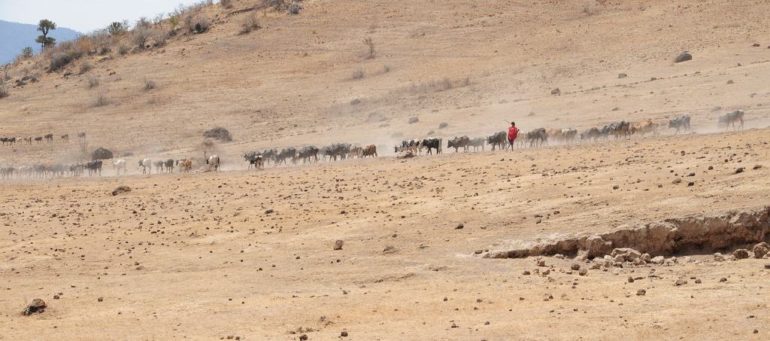Pietro Galgani, a sustainability researcher with the organization True Price, helped conduct a recent study about Maasai land management practices on the Tanzanian steppe. The study is part of a global initiative called TEEBAgFood – The Economics of Ecosystems and Biodiversity for Agriculture and Food – which seeks to measure the value of ecosystems and biodiversity in economic terms. Pietro spoke with Food Tank about the value of pastoralism and how this study can encourage local governments to make environmentally-conscious decisions.
Food Tank (FT): Please describe your study of land management practices of Maasai pastoralists in Tanzania: What question(s) did you ask?
Pietro Galgani (PG): We researched the value of biodiversity in relation to animal husbandry. Maasai pastoralism has been shown to play an important role in conserving ecosystems in the north of Tanzania. This region is a biodiversity hotspot and attracts tourists from all over the world who want to see charismatic wildlife like giraffes, zebras, antelopes, lions, elephants and wildebeest. The region is called the Tarangire-Simanjiro ecosystem and hosts several important national parks. Outside national parks, Maasai pastoralists graze their herds of cows and other ruminants in the Savannah, alongside wildlife.
We wanted to know the economic value of pastoralism in conserving ecosystems.
In the region, sedentary agriculture is expanding. Smallholders farming maize, beans and keeping livestock are members of pastoralist groups or settlers from other regions. An unintended consequence of the trend towards agriculture is the closing of migratory corridors, which is leading to decreases in wildlife populations as well as difficulties for pastoralists who need to drive their herds to fertile grasslands. Another alarming fact is that agriculture is not practiced sustainably; it seems that the majority of farmland is degraded and abandoned after a couple of decades.
The study asks: What is the value of ecosystems – rangeland and agroecosystems – for the local population and national park authorities? More precisely, we looked at how this value changes based on possible alternative futures: a “business as usual” expansion of agriculture or conservation of rangeland.
FT: How did you conduct the study?
PG: We looked at existing scientific knowledge and statistics on food production, milk, meat, crops, forest food, edible plants, and wood harvesting. We also researched revenue from tourism and observed trends of growth or decline in the provision of these ecosystem services. We used this data to calculate the value of natural capital today in the Maasai steppe, depending on how fast conversion of rangeland to agriculture continues in the foreseeable future.
FT: Please describe the term “natural capital” that you use in your study.
PG: We defined natural capital as the benefits that humans get from land. We looked only at the direct benefits like meat, crops or a ticket to the national park. Natural capital is nature seen as a form of wealth and something that supports much of our economy.
Considering natural capital as everything concrete that humans get from an ecosystem shows in hard numbers the economic value that people lose when they degrade that ecosystem. Although focusing on concrete benefits might underestimate the overall value of an ecosystem by leaving out more indirect benefits, we think this approach is useful because the results are very robust.
FT: What were your findings?
PG: The findings show that the direct value of natural capital for local stakeholders in the region assuming “business as usual” is US$2.7 billion. If the conversion of rangeland were to be slowed, the value of natural capital could reach US$4 billion. The results show that although farming extracts more value from the land, it does so in a manner that is not sustainable in the long run (this refers to the most common type of farming currently practiced in the study area: a low input, low output system with no soil fertility management practices). This style of farming also affects the ability of both pastoralists and national parks to reap the benefits of nature. Traditional Maasai pastoralism may seem a low productivity agricultural system, but it has a huge value in conserving key benefits from local ecosystems.
FT: How do the results of your study affect the international movement to encourage more sustainable food systems?
PG: The results show that some costs and benefits hidden in normal economic analysis can be brought into the picture and possibly change the conclusions of a decision maker. In this case, local governments can see the long term implications of extractive agriculture and choose to protect and promote traditional sustainable agriculture. Local governments can protect migratory corridors for wildlife. They can recognize Maasai pastoralism as an important form of sustainable land management and, rather than replace it, help it to develop further.
Natural capital, as well as social and human capital, are different from financial and manufactured capital because they can be regenerated. This kind of study can show that more ecological forms of agriculture can produce food and at the same time increase the value of natural capital, for example by improving the fertility of soils.
FT: How will this study be used? Will you conduct future studies?
PG: This study was one of the first of its kind in the way it looked at the value of land and natural capital. It was part of a large study on livestock within a broader initiative called TEEB (The Economics of Ecosystems and Biodiversity) Agriculture and Food.
We are currently looking into how to go further from here: For example, we could look at the implications of land conversion in Tanzania on social capital. We could apply the same natural capital lens to other animal husbandry systems in environmental hotspots. Or we could investigate more scenarios for the Maasai steppe. In this case, we would like to ask: what would happen if you implemented a more sustainable form of sedentary agriculture, side by side with pastoralism?













